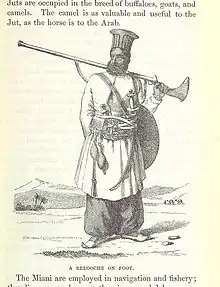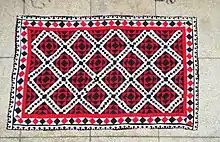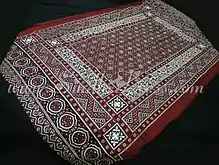Sindhi clothing
Sindhi women wear the Shalwar kameez or the sari and the men wear the shalwar kameez or the kurta with pyjamma. However, before the adoption of the Shalwar kameez, the sari and the kurta, Sindhi's had their own traditional costumes.
 | |
| Type | Dress |
|---|---|
| Introduced | Historic |
Background

Up until the 1840s, women wore the lehenga and choli, and men the lungi or the traditional Sindhi shalwar/suthan. Thereafter, up to the 1930s women began to wear the suthan and Sindhi cholo which was the typical dress for all women of Sindh.[1]
In the past, the younger women wore velvet or amber pyjama (suthan) both at home and outside. Also they wore a long skirt (jablo) on top and a thick poplin blouse (koti) and a white rawa (a muslin head scarf). Middle aged and young ladies wore churidar pyjama (sorhi suthan). Elderly ladies used to wear a white sheet (chaadar) to cover her body with only a peep hole (akhiri) deftly contrived. Over time, older ladies started to wear the Salwar Kurta with Slippers (sapato).[2]
The original dress of the Sindhi male was dhoti, jamo (top) and achi pagirhi (White pagri).[2] The traditional clothes of Sindh can still be seen on men and women today.
Traditional clothing
During the medieval period and prior to the Mughal rule, the costumes worn by the people of Sindh resembled the dresses worn in Iraq and adjoining countries.[3][4] The dresses included short tunics and Iraqi style long robes. If any drawers were used, they were of the Iraqi style, such as the pantaloons which were also adopted in neighbouring Multan and also in the coastal areas of Gujarat.[5] However, the use of such Iraqi clothes in Sindh was limited to Mansura,[6] the Arab capital city, established 712 C.E.[7] and was not universally adopted throughout the region. Arab rule in Sindh ended in 1050 C.E.[8] Further, alongside these dresses, Sindhis also wore other traditional attire.
Traditional Sindhi kancha (shalwar)

The traditional Sindhi drawers are the shalwar[10] style adopted from Iraq[11] and neighbouring countries. The Sindhi shalwar, also called kancha,[12] can be described as wide pantaloons[5] which do not begin to gather at the knees as does the modern Sindhi suthan, and are wide at the ankles.[12] The traditional Sindhi shalwar is similar to the Gujarati kafni,[13] very wide, but the Sindhi shalwar is plaited at the waist.[14] Both garments are loose down to the ankles, where they are gathered. Both garments have the same origins in the pantaloons of Iraq,[13][15] which are still worn by the Kurds.[16][17]
The Sindhi shalwar however, was not universally adopted in the region, where it was limited to Mansura. In time too, Arab rule which introduced the Iraqi dress, ended in the 11th century. Accordingly, the traditional Lungi, ghagra choli and other costumes continued in use.
It is not until the migration of people from Balochistan beginning during the 15th century C.E.[18] and picking up pace during the 18th century C.E.[19] that the use of the shalwar in Sindh was introduced on a wide level. However, the Sindhi shalwar, as the earlier version worn in Mansura, is not as wide and loose as the Balcohi shalwar, which is very wide and loose.[20]
A suthan is traditionally tight fitting below the knees or around the ankles whereas any style of shalwar is loosely gathered at the ankles and does not tighten towards the lower parts of the legs.
Although it was not customary for women to wear the suthan during the early 19th century, men were seen wearing the traditional pantaloon style Sindhi shalwar/suthan during this period.[21] However, the suthan was not universally adopted by members of all religions to begin with,[22] but in 1872 it was noted that the use had spread to a wider audience.[23]
Lengha choli
.jpg.webp)
Before the advent of the suthan and Sindhi cholo, the traditional dress was lengha (jablo) choli which is still worn by women in various parts of Sindh. Women in the Thakparkar district wear a ghagra, a heavier version of the lehnga, with either a loose or fitted choli,[24] or a kancera, a fully embroidered, backless blouse, held on by small cap sleeves and strings.[25]
Another upper garment is the gaji (pullover shirt) which is worn in the mountain areas of Sindh. The gaji is composed of small, square panels, embroidered on silk and sequins. The neck line of the gaji is cut high, and round on one side, with a slit opening extending the other. Unmarried girls wear the opening to the back and married women, to the front.[25]
The original outfit does not require a woman to wear a suthan underneath the lengha, and up until the 1840s, the skirt was commonly worn on its own.[26] Accordingly, the suthan for women is a relatively late adoption.[27] In parts of Sindh, the skirt is worn without the suthan.[28]
Modern Suthan (chareno)
By the 1930s,[1] the suthan, similar to the shalwar became the traditional lower garment worn by women in Sindh.[29] The Sindhi suthan, also called chareno, is similar to the Punjabi suthan of the Punjab region,[30] is heavily pleated, voluminous on the thighs, slightly narrowed on the knees, gathered in at the instep[12] and pleated to the ankles.[31][32][33]
Cholo
The Sindhi suthan was traditionally accompanied by the Sindhi cholo (boddice) and paro (petticoat/ghagra)[34][35] but now is worn with a cholo (kameez) only which is loose fitting,[36] and is made in a variety of ways, including the traditional method of the cholo opening at the front to the waist,[37][38] with very wide sleeves.[39] The traditional cholo can reach down to the ankles.[40]
Women generally wear a dupatta or odani (Veil) with the Sindhi suthan and Sindhi cholo suit to cover their head and shoulders. In the past, women wore a thin muslin scarf (rawa) bigger than the present day dupattas.[2]
Sindhi Julaba
Very loose ankle length garment in hand loom or hand-blocked material with a hood attached, with tie string at "V" opening in the neck and side slits at lower part extending to lower hem. Worn with or without hood in the villages of Sindh and can also be embroidered.[41][42]
Lungi/dhoti
The traditional male lower garment includes the lungi/dhoti.[43] The wrap around the waist continues to be popular in the rural areas which is worn with local upper garments such as the angarkho.
Sindhi Suthan and Sindhi angelo
.jpg.webp)
The other outfit worn by males is the modern Sindhi suthan with the traditional peheren (Sindhi shirt) which is also called angerkho,[1] a short form of the kurta and fastened to the side.[44] An alternative name for the top is angeli which is short and left-crossed, covering the chest, the shoulders and the arms. The sleeves are long and pleated. Large and wide pleats cover the belly.[31] The other upper garment is the traditional garment similar to a long gown.[45]
Sindhi cap
Sindh has its own variety of hat- the Sindhi cap.
Modern clothing
Shalwar kameez
Men and women wear the straight cut Punjabi[46] shalwar kameez using local prints and designs.
Sindhi kurta
The Sindhi kurta is the traditional straight cut variety worn in neighbouring Punjab[47][48] which is becoming increasingly popular in Sindh[49] but uses local patterns to embroider the garment and also makes use of mirrors. The local art of bandhani (creating patterned textiles by resisting parts of a fabric by tying knots on it before it is dyed) is utilised which is believed to have originated in Sindh and spread to Gujarat via Rajasthan[50] and is also practiced in the Punjab region. Sindhi kurtas are also made out of heavy local material called rilli and the kurtas are often called rilli kurtas.[51] Ajrak prints are also used.
 Sindhi hat with Ajrak designs. Scarf with bandhani prints
Sindhi hat with Ajrak designs. Scarf with bandhani prints Ajrak
Ajrak Ralli/rilli material of Sindh
Ralli/rilli material of Sindh Ralli/rilli
Ralli/rilli
See also
- Shalwar kameez
- Khyber Pakhtunkhwa clothing
- Clothing of Balochistan, Pakistan
References
- I Am a Sindhi: The Glorious Sindhi Heritage / The Culture and Folklore of Sind By J. P. Vaswani
- http://blogs.rediff.com/raindrop/2007/07/08/sindhi-2-dress/#comments
- Verma, Harish Chandra (1986) Dynamics Of Urban Life In Pre-Mughal India
- amiyat-ul-Falah (1967)The Voice of Islam, Volume 16
- Kumar, Raj (2008) Encyclopaedia of Untouchables Ancient, Medieval and Modern
- Chandra, Moti (1973) Costumes, Textiles, Cosmetics & Coiffure in Ancient and Mediaeval India
- Hamdard Islamicus, Volumes 3-4 (1980)
- Claus, Peter J. Diamond, Sarah. and Mills Sarah (2003) South Asian Folklore: An Encyclopedia : Afghanistan, Bangladesh, India, Nepal, Pakistan, Sri Lanka
- Census of India, 1901: Baluchistan. 3 pts
- Mumtaz Husain Pathan (1974) Arab kingdom of al-Mansurah in Sind
- Sir Henry Miers Ellio (1850) Bibliographical Index to the Historians of Muhammedan India, Volume 1
- Burton, Richard (1996) Sindh and the Races that Inhabit the Valley of the Indus: With Notices of the Topography and History of [the] Province
- Satish Saberwal, Mushirul Hasan (2006) Assertive Religious Identities: India and Europe
- Reginald Edward Enthoven, Stephen Meredyth Edwardes (1909) Provincial series: Bombay presidency ...
- Said, Hakim Mohammad (1990) Road to Pakistan. 1. 712 - 1858
- Harris, George Lawrence (1958) Iraq
- Laurie, Thomas (1855) Dr. [A.] Grant and the mountain Nestorians
- Bolton, Heather . Shafqat, Saeed (2007) New perspectives on Pakistan: visions for the future
- Gayer, Laurent (2014) Karachi: Ordered Disorder and the Struggle for the City
- Postans, Thomas (1843) Personal Observations on Sindh: The Manners and Customs of Its Inhabitants; and Its Productive Capabilities
- Chablānī, S. P. (1951) Economic conditions in Sind, 1592 to 1843
- Bhowmik, K. L. (1988)Protection And Preservation Of Heritage
- A Gazetteer of the province of Sind (1876)
- United States Treaties and Other International Agreements (1988)
- Peter J. Claus, Sarah Diamond, Margaret Ann Mills (2003) South Asian Folklore: An Encyclopedia : Afghanistan, Bangladesh, India, Nepal, Pakistan, Sri Lanka
- Chablānī, S. P. (1951) Economic conditions in Sind, 1592 to 1843
- Govind Sadashiv Ghurye (1951) Indian costume: (bhāratīya vesabhūsā)
- Raḥmānī, Anjum (2000) Cultural heritage of Pakistan
- Lise Winer (16 January 2009). Dictionary of the English/Creole of Trinidad & Tobago: On Historical Principles. McGill-Queen's Press – MQUP. pp. 808–. ISBN 978-0-7735-3406-3. Retrieved 8 July 2012.
- Punjab District Gazetteers (1932)
- Boivin, Michel (2008) Sindh Through History and Representations: French Contributions to Sindhi Studies
- Mali, Iftikhar.Haider (2006)Culture and Customs of Pakistan
- Focus on Pakistan, Volume 2 (1972)
- I am a Sindhi: The Glorious Sindhi Heritage and Culture and Folklore of Sindh J P Vaswami
- Sindh and The Races That Inhabit the Valley of the Indus Richard F Burton
- Askari, Nasreen and Crill, Rosemary Colours of the Indus: Costume and Textiles of Pakistan (1997)
- Perspective, Volume 3, Issue 2 (1970)
- Weekly of Pakistan, Volume 20, Issues 27-39 (1968)
- Papers by Command, Volume 68. Great Britain. Parliament. House of Commons H.M. Stationery Office, 1979 - Legislation
- Chaukhandi tombs in Pakistan (1996)
- United States Treaties and other International Agreements Vol 29 Part 4
- Papers by Command, Volume 68. Great Britain
- Whose Islam? Pakistani Women's Political Action Groups Speak Out By Kathleen Fenner Laird
- Indian Costume By Govind Sadashiv Ghurye
- Elphinstone, Mountstuart (1842) An account of the kingdom of Caubul, and its dependencies, in Persia, Tartary, and India (1842)
- Basic facts about Pakistan, Issue 5 (7Aar_bqYBA&ved=0CDMQ6AEwAA#v=onepage&q=pakistan%20national%20dress%20punjabi%20suit&f=false Nelson,Lise . Seager,Joni (2008) A Companion to Feminist Geography
- Illustrated Weekly of Pakistan (1968)
- Kumar Suresh Singh, Anthropological Survey of India (2004) People of India, Volume 30, Part 2
- Prakash Bharadwaj. Sindhis Through the Ages: Far-East & South-East Asian countries
- Ranjan, Aditi and Ranjan, M. P. (2009) Handmade in India: A Geographic Encyclopedia of Indian Handicrafts
- Pakistan Exports, Volume 28 (1977)
